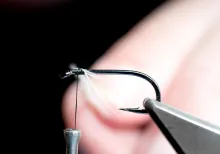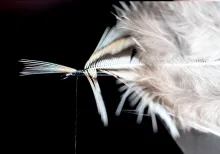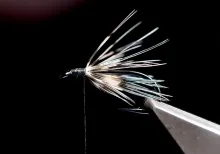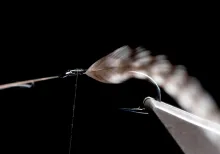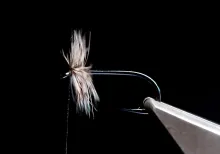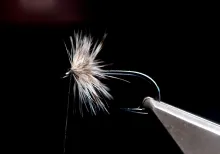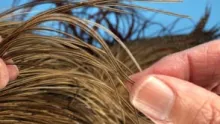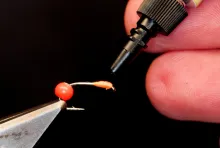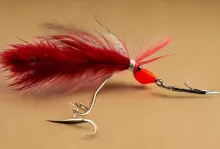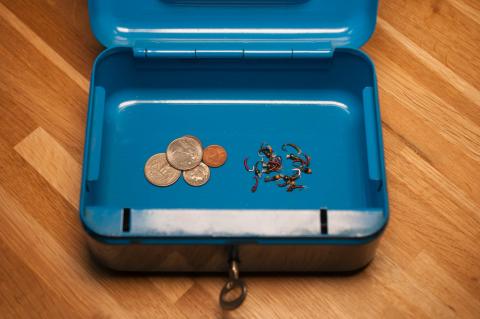Tying in a feather and wrapping it … easy-peasy, right? Or maybe there’s more to it. This in-depth article looks at various ways to make a feather hackle.
Feather hackles are some of the most common elements in fly tying. Hackles are used on a very large number of patterns, and in spite of basically being a feather wrapped around the hook shank, there’s a surprising number of ways this can be done. And there are ways where it’s not even the hook shank that’s the base… and even ways where the feather isn’t wrapped, but still forms a hackle.
Let’s look at some typical - and perhaps some less typical - feather hackles.
Wet fly front hackle
Even though many fly tyers connect the concept of hackles with dry flies and the stiff collars of barbs that often provide the main flotation for these flies, I personally don't consider dry fly hackles as the basic hackle type.
The way I see it, the ur-hackle is the wet fly hackle, and it’s quite likely one of the first ways that feathers were wrapped when people started to dress hooks to become flies. This probably happened sometime as far back as during the Roman empire or perhaps even before that.
The wet fly hackle can be made with a number of different feathers, but is usually done with soft and fairly long fibered feathers, where the barbs sometimes have a slight curve.
The most usual shape of this hackle is sort of umbrella shaped. If you hold the hook vertical, the bend being the handle of the umbrella, the hackle forms the ribs of the umbrella, evenly spread around the shank in one or more layers and curving down. Seen from the front of the hook, the hackle forms a circle or disc, and seen from the side the hackle wraps are often so close that they seem to sit on top of each other and form a paraboloid - like the shape of a satellite dish.
The most common purpose of the hackle is to add some bulk to the fly, and in many cases to imitate appendages like legs, wings, fins, antennae or other parts of a natural animal. Sometimes the wet fly hackle also just adds some movement, which can be a trigger for the targeted fish.
Aesthetically it can also be a way to finish a fly since it can cover the bases of other elements such as wings, wing cases, throat hackles or things that create an undesired bulk in the front of the fly. This function is mostly for the sake of our human eyes, since we must assume that the fish don't care much about how beautiful a fly is.
Some front hackles are very long, sometimes longer than the hook shank, sweeping back over the whole fly. These are often made from teal, mallard and other long barbed variegated feathers and are seen both on imitations and where they can form a translucent body and on other flies where the add a mobile cover along the whole body.
Dry fly front hackle
The dry fly hackle has one premium purpose, and that’s to help the fly float. Because of this, it’s tied with a very special type of feather – dry fly hackle – which is stiff and without web, often with fairly short barbs. It’s also tied on in a special manner – perpendicular to the shank and often quite dense with many close wraps. It’s not uncommon that dry fly hackles consist of two or even three different feathers tied close together “in parallel” or one after the other – "serial" so to say. It’s also common that the hackle fills quite a bit on the hook shank, in spite of being wrapped closely. This gives the fly a larger footprint and better floatability.
To a fish the dry fly hackle will often look like legs resting on the water, and may even imitate fluttering wings above the surface.
Unlike the wet fly hackle, it doesn’t curve or only curves very little, and it doesn’t yield or bend when pushed by water or air – or the fingers for that matter. It’s purpose is to be stiff and not move, and its tips will often rest on the surface of the water, not breaking the surface tension and in that way letting the fly float.
Front hackles – both wet and dry – are sometimes referred to as collar hackles.
Wet fly body hackle
Body hackles are – as the name indicates – wrapped along the body of the fly, and not only in the front.
In some cases this technique is referred to as palmering, and the hackle is called a palmer hackle. You could also refer to them as bugger hackles, because the omnipresent Woolly Bugger can use this style of hackling.
These body hackles can fill the whole body – from the hook bend to the hook eye – or they can just fill part of the fly, often the front half or third. On salmon flies tied in a traditional manner, they often just fill the front half of the body. They can also be compound hackles, where several feathers of varying color or texture are tied after each other or wrapped together in parallel.
The hackle can form an even cylinder with equally long barbs along its full length or they can be tapered along the body. When there’s a taper, by far the most common shape is an increasing barb length from the rear to the front.
On some flies the body hackle will imitate appendages or legs, while it may also imitate body hair or even gills. A full length hackle can also form a translucent body, which a fish might sense as solid in spite of it being formed by feather barbs.
On other fly types such as salmon flies, a body hackle doesn’t imitate anything particular, but adds color, volume and movement to the fly.
The body hackle can be tied in two basic ways: from the front or from the rear. When wrapped from the rear, it's typically tied in tip first, curved side forward before the body is made, and then wrapped when the body is finished. Alternatively it's tied in by the base in front of the finished body, and then wrapped to the rear. This direction requires that a rib or some other material has been tied in to hold it. The rib is counterwrapped to hold the hackle, and then tied down in the front to secure it.
Modified body hackles
Some body hackles are pressed down under the hook shank to form downward pointing legs on flies such as scuds or shrimps, while they may be clipped on other flies to create legs or other appendages pointing in one or several desired directions.
In a few cases the body hackle is clipped almost completely down to form small stubs all over the body, often used to give nymphs and other insects some texture or color.
A special wet fly body hackle is the very long fibered one found on some flies such as spey flies or some modern shrimp imitations. These will typically be made with feathers with very long barbs like heron, spey type hen or rooster, pheasant, goose or even marabou, but are essentially tied the exact same way as any wet fly body hackle.
Martin Joergensen
Half a hackle
When I refer to half a hackle, I mean a one-sided one, where the barbs are removed on one side of the feather stem.
This method is sometimes used to get a thinner hackle with fewer barbs or to get extra good control of the barbs. When removing one side, the remaining barbs will have a tendency to behave a little better, and it can be easier to get them to position consistently and evenly. The barbs are usually removed by simply stripping them off with the fingers, which will also leave the barbless side of the stem smoother than if you were to cut off the barbs with your scissors.
The technique is sometimes used for body hackles on salmon flies where the hackle needs to follow nicely along a rib, which may even be made of several types of tinsel or other materials. By stripping one side of the hackle, you make it easier for the stem to follow the rib and to control the direction and position of the barbs.
Hackles wrapped over smooth surfaces like a tinsel or silk body can benefit from this method too.
It’s also used for dry flies when a very consistent and perpendicular hackle is wanted. The lack of barbs on the inside of the hackle stem makes the outer barbs sit more uniformly and oftentimes straight out from the hook in an almost perfect 90 degrees angle.
Dry fly body hackle
Some dry flies feature a full body hackle, used to help the fly float like the dry fly front hackle. Good examples are the Stimulator and the classic Elk Hair Caddis or even the Griffith’s Gnat, which is barely anything but a body hackle. The simple form is just a dry fly hackle wrapped along the body in open turns rather than in the front of the fly in close turns.
The more complex body hackles can be made from several feathers – again in series or parallel. Sometimes the hackle is clipped like on patterns such as the Super Pupa.
I have also tied caterpillar flies with foam bodies and full body dry fly hackles, which not only float like corks, but also look very much like the real thing.
A special case for the full body dry fly hackle is when it’s used on a Bomber salmon fly where the hackle is wrapped over – and into – a trimmed deer hair body.
Thorax and throat hackles
The thorax hackle is mostly seen on dry flies and nymphs, and is – as the name indicates – wrapped around the thorax of the fly, in other words the front part. On dries it oftentimes consists of two hackle feathers, which are tied in and wrapped around the front part of the fly, both in front and to the rear of the wing(s), in a criss-cross or figure-eight pattern. The hackle becomes kind of “messy” and has barbs that stick out both forwards and rearwards, perpendicular to the body and at an angle. It almost perfectly imitates the legs of a flying insect, while at the same time giving the fly a good surface to float on.
On nymphs the purpose of the thorax is almost always to mimic the legs of the insect. Typically the hackle is sparse and often tied from soft mottled or grizzly feathers that give the legs a more natural appearance.
The throat hackle is a special variation of the wet fly front hackle, and it’s often combined with a traditional front hackle. As the name implies, the throat hackle sits under the front of the hook shank, and is mostly wrapped as a normal front hackle, but then pulled down and secured with tying thread in such a way that is points downwards and rearwards towards the hook point.
It’s used on many flies such as salmon flies and classic streamers, but will also be seen on many nymphs, where it can imitate legs, as well as on baitfish flies where it may look like pectoral and pelvic fins or even gills.
False hackle
Some people also call the throat hackle a false hackle, but I mostly use the term false hackle about a hackle that may look like it’s wrapped as a hackle, but in reality is just one or many bundles of barbs tied in and spread out to look like a wrapped hackle.
Most rearward leaning hackles such as very low, sweeping front hackles, throat hackles or the below mentioned segment hackles can be made as false hackles, in other words tied with barbs only and no stem and no wrapping. If tied up against body material or even a thread bump, the false hackle can be forced to stand out from the body at a steeper angle. Like the spun hackles mentioned later, the false hackle can also utilize barbs from feathers with very long barbs where you only want to use the tip, or barbs from feathers with very stiff stems, like dyed Amherst feathers often used for Intruder style flies.
The false hackle can also be tied using a Y-shaped piece of a feather, where barbs stick out on both sides of a short bit of stem. The barbs are easier to handle this way, and once tied in, the stem is cut away.
Segment hackle
Quite a few flies feature several separated hackles along the body. Many classic and modern grub and shrimp salmon flies have this construction, and modern salmon flies such as the Swedish Ullsock has it. Many Scandinavian sea trout flies also have many hackles, like it’s seen on the Omoe Brush, Brenda, Raccoon and many more. You will also see this hackle style on many tube and shank flies like Intruders.
The hackles are tied like a wet fly front hackle, but they can be located all along the hook shank, mostly separated by some kind of body material like tinsel, floss, yarn or dubbing.
These hackles will mostly be leaning to the rear of the fly, but can sometimes also be the classic umbrella shape of the “pure” wet fly front hackle.
Parachute hackle
The parachute hackle is a dry fly hackle, but in stead of the collar of hackle fibers being vertical, sticking out from the hook shank, they will be horizontal, sticking out from the wing base or some other vertical base sticking up over – or sometimes under – the hook shank.
Tying a parachute hackle is very different from tying other hackles, but the finished hackle is most comparable to the dry fly front hackle inasmuch as it’s quite dense and tied with feathers with stiff barbs.
The hackle style is often found on emerger type flies where the hackle will float the fly, while the rear end of the hook and fly body will hang under the surface. In these cases the hackle will look like legs and wings of the emerging insect, and maybe even as the shuck, which the hatching insect is shedding while getting ready to fly off.
A very special variation of the parachute hackle is the umbrella hackle, where the horizontal hackle is tied on the top of a stem or long wing post mounted on the top of the hook shank, bringing the hackle away from the hook, which will hang suspended under it when it floats.
Tenkara or Deveaux hackle
These two independently developed hackle styles are quite similar, both tied in the front of the fly and both leaning forward over the hook eye, forming a forward pointing funnel.
The style can be used for both wet flies and emergers, where the hackle forms the front appendages of whatever insect the fly is trying to imitate.
I have also seen these forward hackles used on saltwater flies such as Kelvin Kleinman’s Double K Reverse Spider and Tsunami Warning flies. In these patterns the forward leaning hackle forms a mobile ring of fibers, which push water when the fly moves.
Spun hackle
The last type of feather hackle that will be covered here is the spun hackle, where feather barbs are cut from the stem and caught in a thread loop or a split thread, which is then spun to form a brush. This brush is wrapped as any other hackle, oftentimes in such a way that the barbs wind up pointing to the rear of the fly, but sometimes also just left to point in whichever direction they wind up pointing when wrapped.
The technique is mostly used where it’s desirable to get rid of a stiff or thick stem, or to get rid of a very thin and fragile one. It can also be used when it’s difficult to find feathers long enough to actually wrap, creating a need to use barbs from several feathers.
The problem might also be that you have feathers, which have the right color and thickness, but where the barbs are way too long for the hook size. In this case you can trim off the desired length of barbs and catch them in a thread loop to form a “barb brush” with the proper barb length.
When using a spun hackle, it’s not easily possible to get the regular curving wet fly hackle since the barbs will typically be totally mixed and messed up, so mostly the spun hackle is controlled by tying down the bases of the barbs.
A few thread based hackle types are very different from the thread loop style. This is seen on George F. Grant’s flies - where hair is the most common barb material - as well as on flies tied by the Italian tyer Terenzio Zandri. In these cases the barbs are woven into the thread rather than spun.
Henning Eskol
Four ways
A feather can be tied in on the hook shank in four basic ways:
- Tip first, shiny/curved side forward or away from the hook
- Tip first, shiny/curved side rearward or towards the hook
- Stem first, shiny/curved side forward or away from the hook
- Stem first, shiny/curved side rearward or towards the hook
Add to this that you can wrap the hackle forwards or rearwards.
So in case 1 you tie in the feather tip first with its curve forwards, but you can the wrap it both towards the front of the fly and to the rear. The same way you can have two directions on any of the above, giving you eight possible combinations.
All of these can have their applications and while it’s most common to wrap the hackle forwards, there are plenty cases where wrapping towards the rear of the fly makes sense, like when wrapping a body hackle that will be caught by a rib.
|
|
|
|
1 and 3 are the most common methods for softer feathers with thin, pliable stems, where the barbs will naturally be leaning to the rear of the fly.
Shorter feathers with thicker and stiffer stems like partridge and pheasant are often easier to handle using method 1. This will lead to wrapping the softest part of the feather and even let you grip the sturdy base of the feather rather than the fragile tip.
|
|
|
|
For some dry flies it might make sense to tie in with the shiny side or curve towards the fly. This will typically make the hackle bushier and the barbs stand out more prependicular to the hook shank.
For a few types of feathers it doesn’t make a significant difference in the appearance of the final hackle what method you use, because the stem and barbs are very uniform, straight and flat, like it’s found on the best genetic dry fly hackle and some types of large streamer hackles. But you may still see a subtle difference in the result as it's evident on the images below.
Stem shape and quality
When you start getting deeper into hackle wrapping, you will also start to notice that some feathers will act absolutely perfectly while others will do all that they can to be counterproductive. This can be the case for all feathers on a neck, saddle or skin, or just for a few feathers from a skin.
This is almost always caused by the nature of the stem AKA the rachis of the feather. This stiffer, central part of the feather can have all kinds of shapes and be square, round, flat or even almost triangular. The shape is deciding for how easy it is to get the barbs to behave when its wrapped. Many modern hackle feathers from the larger suppliers have been bred to be almost square and to be thin and even. This makes it much easier to wrap the feathers consistently. But natural feather aren't always square or uniform, but oftentimes have odd cross sections and are both tapered and stiff. This is seen very clearly in feathers from game birds such as partridge and pheasant. These feathers still make excellent hackles, but just need to be handled according to their nature as described several places above.
Some individual feathers also have kinked or twisted stems, and sometimes you can be happily wrapping away, everything being in perfect order, and then suddenly everything goes south and won’t behave at all. That will very often be caused by a kinked feather stem. The easiest solution is to unwrap and select another feather. Some kinks and twists can be removed by steaming the feather – or the whole skin.
- Log in to post comments

































